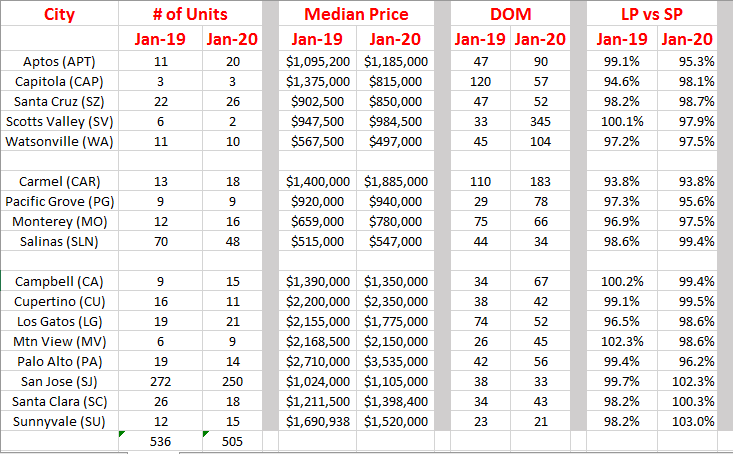February 2020
Moratorium Issued on Insurance Non-Renewals
Insurance Commissioner Ricardo Lara has issued a mandatory one-year moratorium on insurance companies not renewing policies for homes in wildfire disaster areas in Northern and Southern California.
Additionally, because the homeowner insurance crisis extends beyond the wildfire perimeters and impacts homeowners statewide, Commissioner Lara went a step further and called on insurance companies to voluntarily cease all non-renewals related to wildfire risk statewide until December 5, 2020.
If a homeowner has received a notice of cancellation or non-renewal that homeowner should contact their insurance company to seek a reinstatement of the policy. If the insurer refuses, the homeowner is encouraged to contact the California Department of Insurance and file a Request for Assistance.
Time Spent Searching for a Home is Rising
Of the 11% of American adults considering a home purchase in the final quarter of 2019, only 43% reported being actively engaged in the process to find and buy a home. A year earlier, the comparable share of active buyers was a much stronger 54%.
Results from the latest Housing Trends Report also show that the time active home buyers are spending searching for a home is rising. In the final quarter of 2019, 60% of actively engaged buyers reported having spent at least 3 months searching, compared to 58% a year earlier. This marks the fourth consecutive year-over-year gain in the share of active buyers who have spent upwards of 3 months looking for a home to buy. This trend is closely related to persistently low levels of inventory of new and existing homes for-sale.
One of the more fascinating trends from the recent 2019 Profile of Home Buyers and Sellers is the rising age of home buyers. Overall, buyers' ages have jumped from a median of 31 in 1981 to 47 in 2019.
From 1981 to 2018, the first-time buyer age was actually a pretty boring, flat line which fluctuated between 28-32. The only movement outside of this was in 2019, when it slightly increased to the median age of 33. Not a huge change but enough to know there are other factors at play.
The number that has changed dramatically since 1981 is the rise in the age of repeat buyers. Repeat buyers were a median age of 36 in 1981 and are now at 55. This incremental climb can be attributed to a number of factors. Many are staying in their homes for longer periods of time, Americans are also living and working longer, some are having children later in life and life decisions are getting pushed further into the future. Many parents are holding onto their family home as adult children boomerang back after college.
What is of note of these home buyers who are a median age of 55 is that they plan on staying in their homes for 15-20 years and many are never planning to move. If that holds true this could have a greater impact on the availability of homes in the future.
As REALTORS(R), we pledge to live by the Code of Ethics outlined by the National Association of REALTORS. NAR commemorated the 50-year anniversary of the Fair Housing Act in 2018, and fair housing has been enshrined in the REALTOR(R) Code since 1974, at the time mirroring the federally protected classes. In the years since, REALTORS(R) have moved ahead of these federal protections, adding sexual orientation and gender identity as protected classes in 2010 and 2013, respectively.
But not all of us give these issues the attention we should. While Article 10 of NAR's Code of Ethics directly addresses fair housing policies, discrimination in our industry can manifest itself in the form of a lack of cooperation. Some may argue that ongoing experience makes clear that brokers, even unintentionally, may shun cooperation with a broker whose non-native spoken English is difficult to understand or whose color leads to an automatic presumption that their client isn't qualified.
With these scenarios and many others in mind, I am pleased to inform you that NAR's Board of Directors recently approved a new standard of practice to Article 3, effective Jan. 1, 2020: REALTORS(R) may not refuse to cooperate on the basis of a broker's race, color, religion, sex, handicap, familial status, national origin, sexual orientation, or gender identity. That which was previously implicitly prohibited is now explicitly prohibited.
We are REALTORS(R). We welcome and embrace equal housing opportunity. We welcome and embrace cooperation with even our fiercest competitors whenever it works to our clients' benefit. Because that's who we R.
Comments: Not much of a change in the number of units sold year over year (536 to 505). What was interesting is the sales dropped in Salinas and San Jose, the larger areas. The overall average median price was up in Santa Cruz County ($825-$869), up in Monterey County ($590-$648), and up in Santa Clara County ($1,169M-$1,200M). Nothing significant to access from the changes in DOM and list to sale price ratio, most likely because of the time of the year and the amount of sales. Display of MLS data is deemed reliable but is not guaranteed accurate by the MLS.
The Age of Buyers is Skyrocketing
The REALTORS Code of Ethics
January over January Comparisons for the Bay Area & Central Coast


